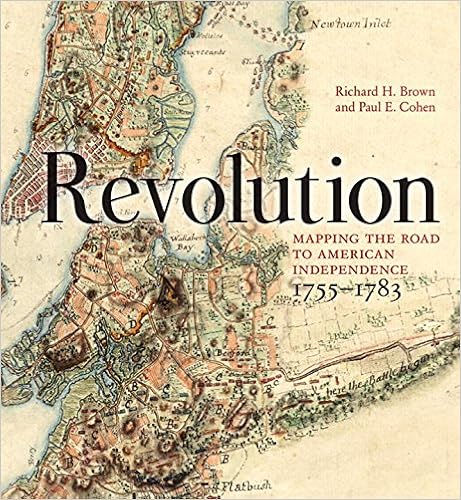
Free Downloads Revolution: Mapping The Road To American Independence, 1755-1783

The spectacular legacy and importance of early American cartographers.Historians of the Revolutionary War in America have been fortunate in their resources: few wars in history have such a rich literary and cartographic heritage. The high skills of the surveyors, artists, and engravers who delineated the topography and fields of battle allow us to observe the unfolding of events that ultimately defined the United States.When warfare erupted between Britain and her colonists in 1775, maps provided graphic news about military matters. A number of the best examples are reproduced here, including some from the personal collections of King George III, the Duke of Northumberland, and the Marquis de Lafayette. Other maps from institutional and private collections are being published for the first time. In all, sixty significant and beautiful cartographic works from 1755 to 1783 illustrate this intriguing era.Most books about the Revolution begin with Lexington and Concord and progress to the British surrender at Yorktown, but in this rich collection the authors lay the groundwork for the war by also taking into account key events of the antecedent conflict. The seeds of revolution were planted during the French and Indian War (1755–1763), and it was then that a good number of the participants, both British and rebel, cut their teeth. George Washington took his first command during this war, alongside the future British commanding General Thomas Gage.At the Treaty of Paris, the French and Indian War ended, and King George III gained clear title to more territory than had ever been exchanged in any other war before or since. The British military employed its best-trained artists and engineers to map the richest prize in its Empire. They would need those maps for the fratricidal war that would begin twelve years later. Their maps and many others make up the contents of this fascinating and beautiful book. 60 maps

Hardcover: 160 pages
Publisher: W. W. Norton & Company (October 26, 2015)
Language: English
ISBN-10: 0393060322
ISBN-13: 978-0393060324
Product Dimensions: 12 x 0.8 x 12.9 inches
Shipping Weight: 3.2 pounds (View shipping rates and policies)
Average Customer Review: 4.6 out of 5 stars See all reviews (10 customer reviews)
Best Sellers Rank: #258,351 in Books (See Top 100 in Books) #40 in Books > Science & Math > Earth Sciences > Cartography #90 in Books > History > Historical Study & Educational Resources > Historical Maps #404 in Books > Reference > Atlases & Maps > United States

This collection of antique maps and concise commentary is visually stunning and beautifully written. At a time when readers require reasons to purchase a book in hardcover rather than in digital form, this volume offers many. First of all, it is a very elegant work. Laura Lindgren, the jacket designer, uses an 18th C. full-color military map of New York City for the cover, the spaces for modern text provided by an artful fading of the map. The names of the authors are in the upper right, and the title is boldly printed across the center. The dust jacket is heavy polished paper. A ribbon of map (this time of the Fort George Area) tops the back cover above three reviews on burgundy background. One of these endorsements is by Ric Burns, the documentarian. The book is oversize in format, 12X13 inches, but is slender at 150 pages, more than enough space to cover thirty years of revolutionary history starting with the French and Indian War. The maps included have been rarely or never published before.Unlike many recent historical atlases, the focus in this volume is always on the maps. While the authors include many illustrations, they are always closely related to the maps. For example, the Anti-Gallican Map of North America (1755), published by a British anti-French club, is accompanied by an illustration of the badge of the President of the organization. It is a gorgeous rococo jewel which depicts St. George impaling the French flag with his spear. The map and badge clearly illustrate the British hostility to the French just before the onset of war.One of the reviewers on the cover, Jane Kamensky, notes that "the battle for (and against) American independence unfolded in space as well as in time.
Revolution: Mapping the Road to American Independence, 1755-1783 The Quartet: Orchestrating the Second American Revolution, 1783-1789 Mapping Australia (Mapping the World (Gareth Stevens)) 3D Robotic Mapping: The Simultaneous Localization and Mapping Problem with Six Degrees of Freedom (Springer Tracts in Advanced Robotics) Mapping South America (Mapping the Continents) The Revolutionary War: 1775-1783 (See American History) An Illustrated History of Uniforms from 1775-1783: The American Revolutionary War Thomas Jefferson and the Declaration of Independence (Graphic Heroes of the American Revolution) Independence Lost: Lives on the Edge of the American Revolution Revolution on the Hudson: New York City and the Hudson River Valley in the American War of Independence ParaPro Assessment Study Guide, Test Codes 0755 and 1755 (The Praxis Series) (Praxis Study Guides) John Adams: Revolutionary Writings, 1755-1775 (Library of America, No. 213) British Redcoat vs French Fusilier: North America 1755-63 (Combat) Praxis II: ParaPro Test Prep (0755-1755) Ross Poldark: A Novel of Cornwall, 1783-1787 John Adams: Revolutionary Writings 1775-1783 (Library of America, No. 214) Mapping the Silk Road and Beyond: 2,000 Years of Exploring the East The Simple Path to Wealth: Your road map to financial independence and a rich, free life The Declaration of Independence (True Books: American History (Paperback)) American Treasures: The Secret Efforts to Save the Declaration of Independence, the Constitution and the Gettysburg Address



